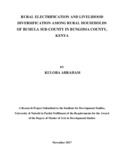| dc.description.abstract | Livelihood diversification is a common approach for coping with economic and environmental jolts, and is instrumental in poverty reduction. The case is particularly true for rural electrification and livelihood diversification, where rural livelihood diversification rely on electricity powered micro-enterprises. Nevertheless, past studies on rural electrification focus more on the effects that rural electrification have on the enhancement of social welfare generally by exposing individuals to news media, allowing extended studies and revisions for children. Further to this, past studies generally examine the extent of rural electrification coverage and community-based electric grids. To deepen our conceptual understanding of rural livelihood diversification processes, this study examined the influence that rural electrification grid connections have on livelihood diversification through establishment of rural micro-enterprises. Thus the study argued that rural electrification contributed to the establishment of micro-enterprises that supported livelihood diversification.
The study interviewed one hundred micro-enterprises engaging in different nature of activities in Bumula sub-County in Bungoma County, Kenya. Primary data from micro-enterprises were corroborated with secondary data collected from two key informants from West Kenya Rural Electrification offices in Eldoret. Both quantitative and qualitative data were collected by use of a questionnaire with both structured and unstructured items and key informant guides. Data collected from respondents in micro-enterprises were analysed using IBM Statistical Package for the Social Sciences (IBM SPSS 24) while thematic analysis was employed in the analysis of data collected from the key informants.
The study found that rural electrification supported the establishment of micro-enterprises such as welding services, barber shops, salons etc. Proprietors’ gender, income level and level of education was an essential determinant of the different type of micro-enterprises one established. The study concludes that rural electrification contributed to the emergence of micro-enterprises, thus supported livelihoods diversification. The study recommends that the National and County Government in concert with electricity service providers and related agencies to reconsider the maximum 600 metres distance required for rural electricity connection to accommodate more individuals in the rural areas. | en_US |



